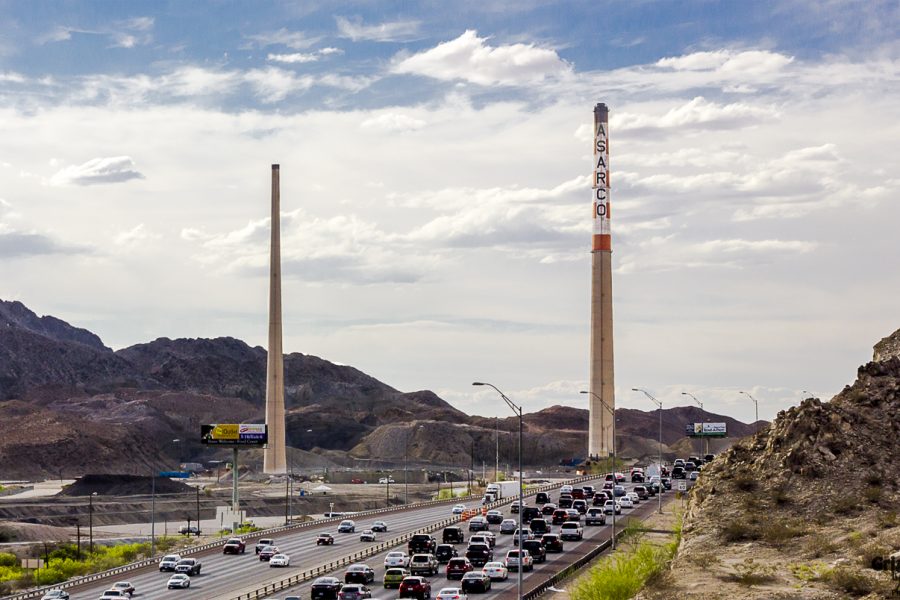“The Town and the Smelter” is the latest exhibit featured at the UTEP Centennial Museum, which showcases photographs and artifacts taken from a place and period in time that is still remembered by the El Paso community.
The American Smelting and Refining Company, better known as ASARCO, has buried its roots deep into the history of El Paso and the border.
“ASARCO shaped the Borderland by creating high-paying jobs and becoming a regional economic engine,” reads an excerpt at the Centennial exhibit. “Yet, the smelter also brought horrendous workplace accidents, pollution and toxic waste that poisoned the community.”
Founded in 1888, in the midst of the American industrialization, the smelter sought to mine the natural resources of the land by burning fossil fuels. It remained a popular practice nationwide for the following century, though the long-term damage to human health and the environment was widely unforeseen.
Today, there is evidence that points to ASARCO as the cause of multiple health problems observed in more than 50 former employees in El Paso. UTEP graduates Elaine Hampton and Cynthia Ontiveros found this as they conducted research. Tasked with creating a curriculum for elementary students based on air quality in 2015, the pair teamed up with the university’s Environmental Offices and the El Paso Independent School District to tell the story of “Smeltertown.” With a grant from the Environmental Protection Agency, they proceeded to record the stories of 65 former ASARCO employees.
“We really wanted to keep that story alive,” Hampton said. “And a piece of that was ‘Well, there’s some of the men who have worked in the smelter and they have some stories to tell.’ So we started interviewing those men and when the men told us those stories, they were fascinating.”
Of the 64 men and one woman interviewed, 55 said that they had developed some form of respiratory, gastrointestinal, skin or bone disease years after working at the ASARCO plant, 14 even developed cancer.
“When you look at the chemicals that were produced or let out into the air, the chemicals they were exposed to, all of these things certainly can be attributed to the exposure of (the chemicals),” Hampton explained.
Despite these findings, there was still insufficient evidence to hold ASARCO accountable and many of the former employees were unable to receive compensation for their declining health.
Health problems that developed later in their lives were not the only negative factors that former ASARCO workers faced. The workplace conditions were alarmingly unsafe and many accidents ensued over the years as a result. Smeltertown was not the only case, however, as hundreds of factories across the nation experienced similar conditions.
Unsafe factory environments were commonplace throughout the U.S’s industrial era, though it is difficult to decipher why these factories operated that way.
“There was an attitude in our country that we were going to be the best industrial country, we’re going to have the best materials, the best manufacturing, the best mines, the best coal industry, the best gasoline … and so laws were designed so that those kinds of industries could continue forward with very little opposition, very little regulation,” Hampton said.
Perhaps the most notable part of the exhibit and of ASARCO’s story is the scientific breakthrough made possible by studies done in the area surrounding the plant in the 1970s.
“I think the important thing is that, right around 1970, would be when the United States was understanding how dangerous chemicals were,” Hampton said.
Hampton added how Joe Piñon, a local pharmacist, uncovered much of what we know now about the negative health effects caused by toxic fumes.
“He was the one who did that famous study, drawing concentric circles around the smelter, testing the levels of lead in the blood of the children in each of those spots … That is proof that, if you are close to ASARCO, your children had much more lead exposure,” Hampton explained.
This breakthrough, in conjunction with a number of other isolated incidents, was what ultimately lead to the closing of the El Paso ASARCO plant in 1999, followed by its demolition in 2013.
The museum’s exhibit showcasing one of El Paso’s historic landmarks will run through Jan. 25 of next year.











